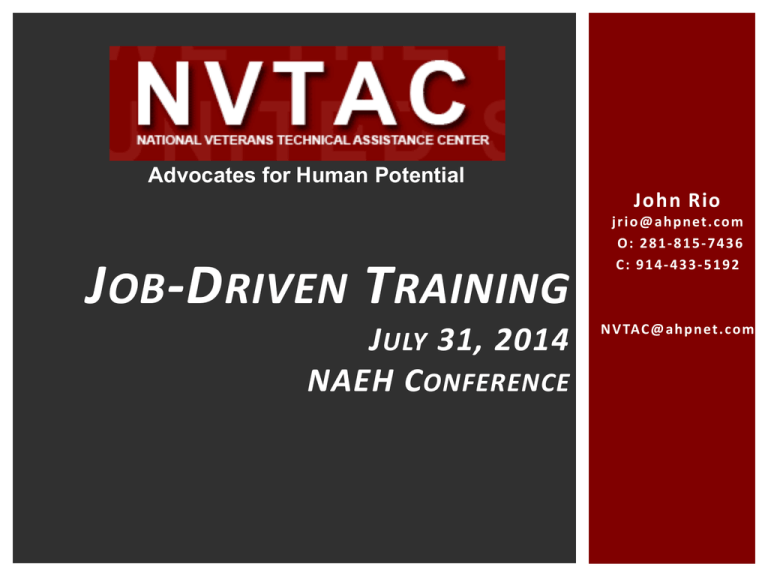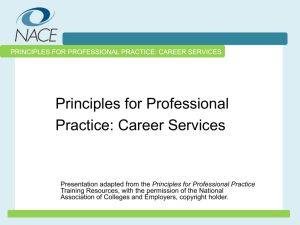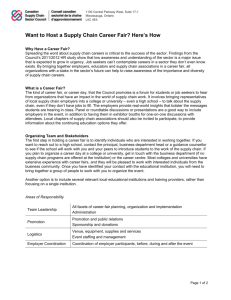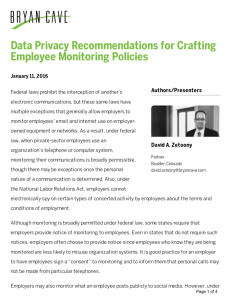Job Driven Training Presentation
advertisement

Advocates for Human Potential John Rio JOB-DRIVEN TRAINING J ULY 31, 2014 NAEH C ONFERENCE j r i o @ a h p n et . c o m O : 2 8 1 - 8 1 5 - 74 3 6 C: 914-433-5192 N V TAC @ a h p n et . c o m j r i o @ a h p n et . c o m M AJOR TASKS AT NVTAC 1. Provide TA & Training to HVRPs 2. Identify Best Practices and Support Other Research 3. Respond to Inquiries 4. Disseminate Information to Stakeholders 5. Outreach to Employers 2 E MPLOYMENT P RACTICE P RINCIPLES 1. Honor military veterans service, experience and family 2. Provide employment service to all comers 3. Integrate employment and supportive services, including housing 4. Competitive employment is the goal 5. Provide benefits counseling 6. Partner with employers 7. Rapid job matching 8. Engage customers based on their preferences 9. Provide job retention services 10. Job training choices linked with labor market needs 3 I SSUES IN W ORKFORCE DEVELOPMENT 1. EMPLOYERS can’t find enough skilled workers to hire for in-demand jobs they must fill to grow their businesses. 2. EDUCATION AND TRAINING PROGRAMS need better information on what skills those in -demand jobs require. 3. HARD-WORKING AMERICANS, whether studying, looking for work, or wanting better career paths, often aren’t sure what training to pursue and whether jobs will be waiting when they finish. 4 F EATURES OF J OB -D RIVEN T RAINING Focus on job market demands Relies on employer partnerships Collaboration with occupational training services Training based on in-demand jobs On the job training Apprenticeships Matches skilled jobs with job seekers 5 E ARN AND L EARN A PPROACH Training is not classroom centered Employers are involved in curriculum development and training delivery Meeting requirements for reading, math, as well as soft skills are not stand alone activities but are incorporated into occupational skill training Trainees receive an income 6 M AKING R IGHT C HOICES Program offerings Job seeker training and career choices 7 M EASUREMENT M ATTERS How well do job seekers acquire needed skills? Do job seekers complete the program? Are trainees getting jobs for which they received training? Are customers satisfied? Are trained works advancing? 8 S TEPPING S TONES Progressive pathway To succeed at basic education to postsecondary programs 9 O PEN D OORS Role as a workforce intermediary Breakdown barriers to training Vocational case management Streamline access to training and jobs Wrap around supports as needed 10 L OCAL & R EGIONAL PARTNERSHIPS Who might you connect with? How can you form a consortium to address employer development and job seekers in your community? What are some initial steps you might take? 11 U NDERSTANDING JOB MARKET DEMANDS What are the labor needs of employers in your local market? 12 W HAT DOES JDT MEAN FOR SMALL EMPLOYMENT PROGRAMS ? Partnering with local job training programs Identifying local niche markets where employers need talented labor Review employer job descriptions, flesh out the competencies needed for those jobs Engage your local American Job Center (AJC) 13 E XAMPLE – D ENVER ’ S R OAD TO W ORK Focused on the hospitality sector & needs of its employers Started with 3 employers – now includes 21 hotels and hospitality businesses Employer guided curricula, delivered by employers and the intermediary Trainees receive a stipend Intern at hotels in job shadowing experiences 14 E MPLOYER D EVELOPMENT P ORTFOLIOS WWW. EDPSITE . COM 15 R ESOURCES Job Centers http://www.servicelocator.org/onestopcenter s.asp Apprenticeships: http://www.doleta.gov/oa/ Sector Initiatives: http://www.insightcced.org/communities/nns p.html Job Driven Training http://social.dol.gov/blog/promoting-jobdriven-training-and-american-opportunity/ 16











